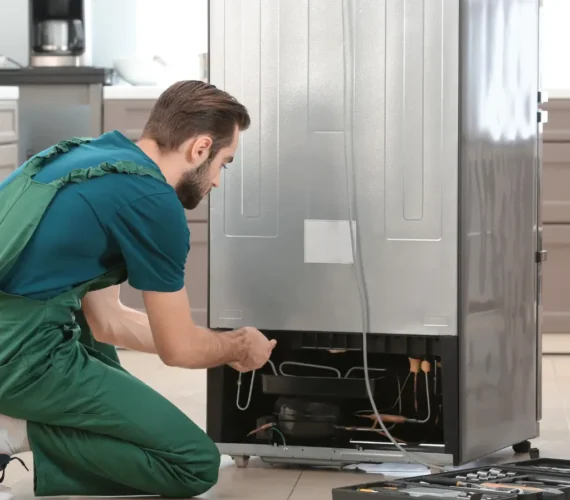
Maintenance for Refrigerator: A Complete Guide to Prolong Lifespan and Efficiency
Refrigerators are an essential appliance in every home, ensuring food stays fresh and safe for consumption. However, like any other machine, they require regular maintenance to perform efficiently. Proper refrigerator maintenance not only prolongs its lifespan but also helps reduce energy consumption, which can save you money in the long run. In this guide, we’ll cover essential tips and strategies to keep your refrigerator in top condition.
1. Why Refrigerator Maintenance Matters
A well-maintained refrigerator:
- Preserves Food Quality: Keeps food fresh longer, reducing waste.
- Saves Energy: An efficient fridge uses less power, cutting down on electricity bills.
- Extends Appliance Life: Regular care can prevent costly repairs or premature replacements.
- Ensures Safety: Proper maintenance helps avoid potential hazards like leaks or overheating.
2. Daily and Weekly Maintenance Tips
A. Check and Adjust Temperature Settings
- Optimal Temperature: Set the refrigerator between 37°F to 40°F (3°C to 4°C) and the freezer at 0°F (-18°C).
- Thermometer Use: Place a thermometer inside periodically to ensure accuracy.
B. Keep It Clean Inside and Out
- Interior Cleaning: Wipe spills immediately with a damp cloth to prevent odor and bacterial buildup.
- Exterior Cleaning: Use a mild detergent to clean doors and handles weekly.
- Gasket Care: Clean door seals with warm soapy water to maintain their flexibility and ensure a tight seal.
C. Organize Food Properly
- Airflow Maintenance: Avoid overfilling; leave space for air circulation.
- Use Zones Wisely: Store raw meats in designated drawers to prevent cross-contamination, and keep fruits and vegetables in crisper drawers.
3. Monthly Maintenance Tips
A. Clean the Condenser Coils
- Why It Matters: Dirty coils force the fridge to work harder, increasing energy consumption.
- How to Clean: Unplug the fridge and use a coil brush or vacuum to remove dust from the coils located at the back or underneath.
B. Check and Replace Water Filters
- Water Quality: Replace water filters every 6 months or as per the manufacturer’s recommendation.
- Signs of Replacement: Reduced water flow or a change in taste indicates it’s time for a new filter.
C. Inspect the Door Seals
- Test Seal Integrity: Close the door on a piece of paper or dollar bill. If it slips out easily, the gasket may need cleaning or replacing.
- Seal Replacement: Replace worn or cracked seals to prevent cold air from escaping.
4. Seasonal and Annual Maintenance Tips
A. Defrost the Freezer (If Manual)
- Why Defrosting Matters: Excess frost buildup can hinder cooling efficiency.
- How to Defrost: Unplug the fridge, remove all contents, and let the ice melt naturally or use a bowl of hot water to speed up the process.
B. Deep Clean the Drip Pan
- Location: Usually located underneath the refrigerator.
- Cleaning Steps: Slide out the pan and clean it with warm, soapy water to remove any accumulated debris or mildew.
C. Inspect the Evaporator Fan
- Noise Check: Listen for unusual noises; a faulty fan may cause inconsistent cooling.
- Clean and Inspect: Ensure the fan blades are free from dust and debris, and replace the fan if necessary.
5. Energy Efficiency Tips
A. Keep the Refrigerator Full
- Thermal Mass: A full fridge retains cold better, reducing the frequency of the compressor turning on.
- Use Water Bottles: If the fridge is not full, store bottles of water to maintain cooling efficiency.
B. Maintain Proper Ventilation
- Placement: Ensure at least a few inches of clearance around the fridge for proper airflow.
- Avoid Heat Sources: Keep the refrigerator away from ovens, dishwashers, or direct sunlight.
C. Use Energy-Saving Mode
- Eco Settings: Many modern refrigerators come with an energy-saving mode. Activate it to reduce power consumption when full cooling power isn’t necessary.
6. Troubleshooting Common Issues
A. Refrigerator Not Cooling
- Check Power Supply: Ensure the plug is securely connected and the outlet is functioning.
- Thermostat Setting: Verify the thermostat is set correctly.
- Coil Check: Ensure condenser coils are clean and free from dust.
B. Unusual Noises
- Level the Refrigerator: Use a level tool to ensure the fridge is stable on the floor.
- Inspect Fans: Clean the evaporator and condenser fans, which might accumulate dust.
C. Water Leaks
- Clogged Drain: Clear the defrost drain using warm water and a pipe cleaner.
- Damaged Drip Pan: Check for cracks in the drip pan and replace if necessary.
7. When to Call a Professional
While regular maintenance can handle most issues, some problems require professional intervention. Call a technician if:
- The fridge isn’t cooling even after troubleshooting.
- There’s excessive frost buildup despite defrosting.
- You hear persistent loud noises or the compressor runs continuously.
Conclusion
Regular refrigerator maintenance is essential to ensure it operates efficiently, saves energy, and lasts for years. By following the daily, monthly, and annual tips outlined in this guide, you can prevent costly repairs and keep your appliance running smoothly. Remember, a well-maintained refrigerator not only preserves your food but also contributes to a more energy-efficient home. Take proactive steps today to ensure your fridge remains in top shape!
